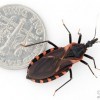Abstract
The eastern bloodsucking conenose belongs to the subfamily Triatominae, known as the kissing bugs. Despite their affectionate vernacular name, they are particularly threatening “assassin bugs” who require blood meals to survive and reproduce. They are a known vector of American trypanosomiasis (or Chagas Disease) in South America, a debilitating illness caused by the parasite Trypanosoma cruzi. This disease is a problem in South and Central America and has been detected in the United States, but has not been found in Florida. This 4-page fact sheet was written by John L. Capinera, and published by the UF Department of Entomology and Nematology, November 2013.
http://edis.ifas.ufl.edu/in1018
References
Bern C, Kjos S, Yabsley MJ, Montgomery SP. 2011. Trypanosoma cruzi and Chagas disease in the United States. Clinical Microbiology Reviews. 24: 4. https://doi.org/10.1128/CMR.00005-11
Capinera JL. 2010. Insects and wildlife: arthropods and their relationships with wild vertebrate animals (1st edition), Wiley-Blackwell, Chichester, West Sussex, UK, pp. 302-303. https://doi.org/10.1002/9781444317688
Center for Disease Control and Prevention. 2013. Parasites - American trypanosomiasis (also known as Chagas disease). (14 November 2013).
Cesa K, Caillouët A, Wesson DM. 2011. High Trypanosoma cruzi (Kinetoplastida: Trypanosomatidae) prevalence in Triatoma sanguisuga (Hemiptera: Reduviidae) in Southeastern Louisiana. Journal of Medical Entomology. 48:1091-1094. https://doi.org/10.1603/ME10195
Drees BM, Jackman J. 1999. Kissing bug, conenose bug, masked hunter. Field guide to Texas insects, Gulf Publishing, Houston, Texas. (14 November 2013).
Griffith ME. 1947. The bloodsucking conenose, or "big bedbug," Triatoma sanguisuga (LeConte), in an Oklahoma City household. Proceedings of the Oklahoma Academy of Science. 28: 24-27.
Grundemann A. 1947. Studies on the biology of Triatoma sanguisuga (LeConte) in Kansas, (Reduviidae, Hemiptera). The Journal of the Kansas Entomological Society. 20:3.
Hays KL. 1965. Longevity, fecundity, and food intake of adult Triatoma sanguisuga (LeConte) (Hemiptera: Triatominae). Journal of Medical Entomology 2: 200-202. https://doi.org/10.1093/jmedent/2.2.200
Kobylinski K, Connelly RR. 2006. Blood feeding insect series: American trypanosomiasis - Chagas disease. Electronic Data Information Source, UF/IFAS. (no longer available online).
Lent H, Wygodzinsky P. 1979. Revision of the Tratominae (Hemiptera, Reduviidae), and their significance as vectors of Chagas' disease. Bulletin of the American Museum of Natural History. 163: 1-520.
Maurer L. 2013. Triatoma sanguisuga. Animal Diversity Web. (14 November 2013).
Rand M. 2011. Zoonotic diseases: institutional policies and procedures. Office of Research, The University of California, Santa Barbara. (14 November 2013).
Triplehorn CA, Johnson NF. 2005. Borror and Delong's introduction to the study of insects (7th edition), Brooks/Coles, Belmont, California. p 297.
Unless otherwise specified, articles published in the EDIS journal after January 1, 2024 are licensed under a Creative Commons Attribution-NonCommercial-NoDerivs 4.0 International (CC BY-NC-ND 4.0) license.

